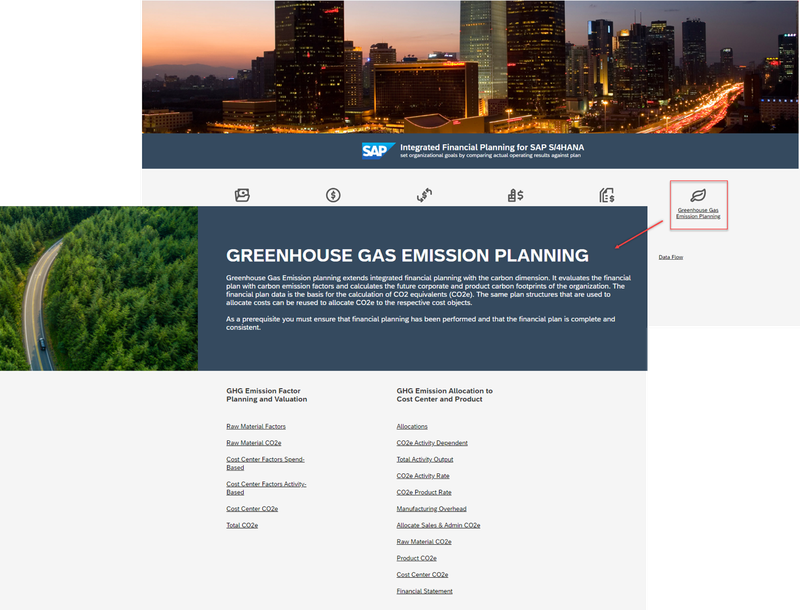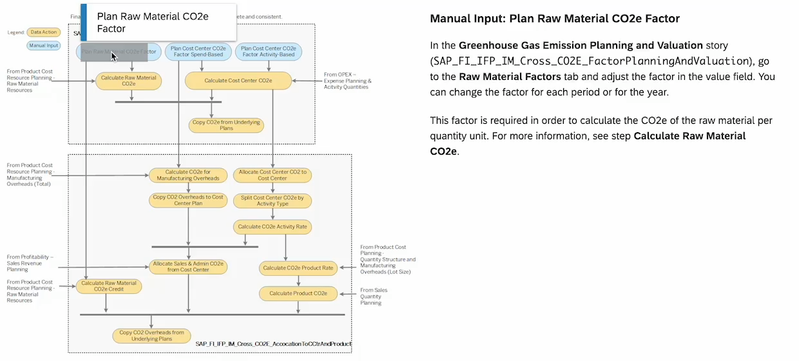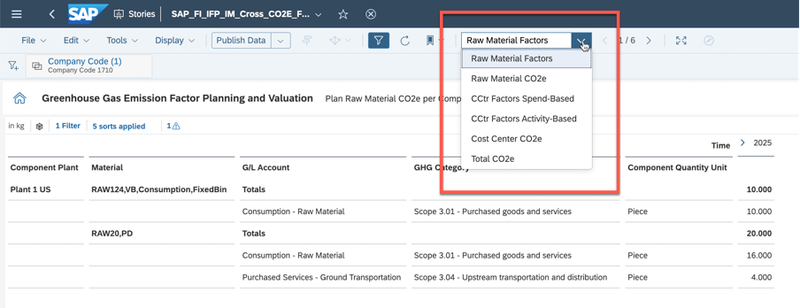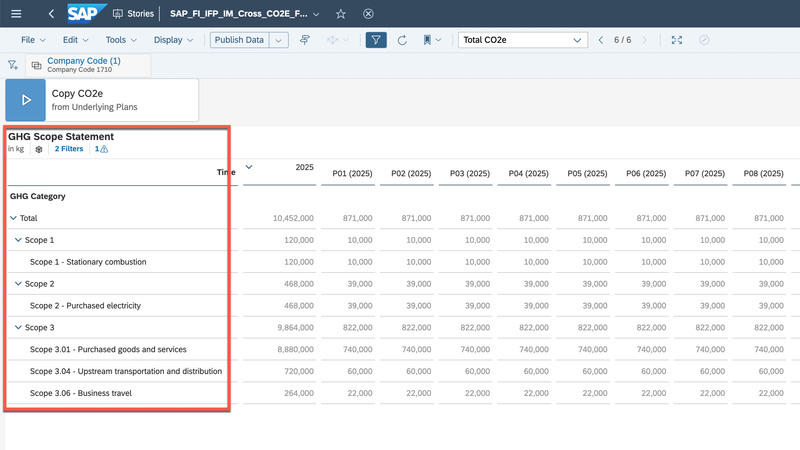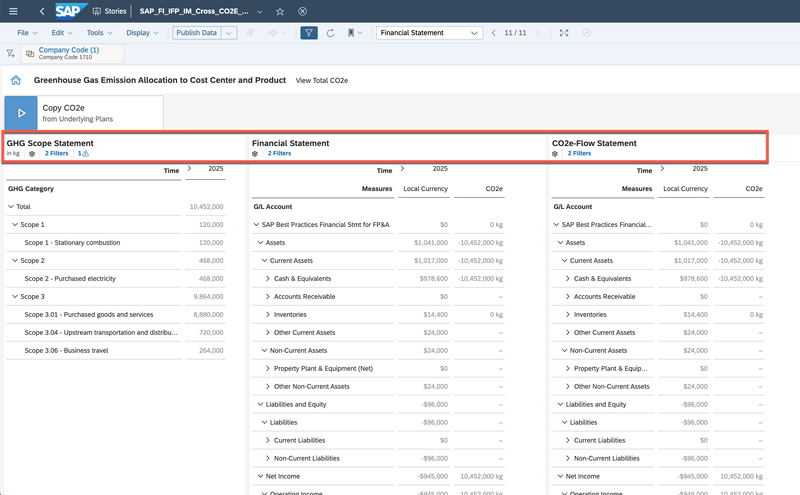
- SAP Community
- Products and Technology
- Enterprise Resource Planning
- ERP Blogs by SAP
- Driving Corporate Sustainability: Greenhouse Gas E...
- Subscribe to RSS Feed
- Mark as New
- Mark as Read
- Bookmark
- Subscribe
- Printer Friendly Page
- Report Inappropriate Content
Introduction
With the 2024 Q1 business content release for SAP Analytics Cloud, SAP is now expanding integrated financial planning to also include greenhouse gas emissions for Cloud ERP. This enhancement will help companies to plan their future corporate and product carbon footprints and is another significant step towards SAP's Green Ledger.
With this post I want to share with you how this is embedded in the enterprise business planning process. Additionally going into more details on how the solution uses sales, production, and financial data to simulate scenarios and forecast expected outcomes based on various driver parameters, such as emission factors for raw materials or energy sources. Companies can use this data to achieve their sustainability goals, identify specific areas for action, and manage the financial impact.
Integrating sustainability metrics into the financial planning process can help achieve sustainability goals, optimize costs, and create long-term value for the company.
Fig. 1: GHG planning along green ledger
The diagram illustrates how GHG emissions planning with SAP Analytics Cloud uses sales quantities, material resource, or expense planning to calculate product and corporate footprints. The solution can be integrated with SAP Sustainability Footprint Management to obtain the product emissions data required for the planning process. Combined with the planned SAP Carbon Accounting Hub, which will account for actual greenhouse gas emissions within S/4HANA financial processes, SAP Analytics Cloud is another important step toward a green ledger.
Key Benefits:
- Operationalize greenhouse gas emissions as part of the business steering & planning model
- Plan enterprise corporate and product footprint, in relation to finance, enabling you to plan and optimize accordingly
- Set up Greenhouse Gas emissions plans integrated into your enterprise business planning like sales or production plan to identify financial risks and costs associated with greenhouse gas emissions
- Enable resilient, sustainable and profitable business models to protect enterprise long-term value
- Simulate and forecast enterprise Greenhouse Gas emissions based on different scenarios
- Bring Greenhouse gas emission in close alignment with financial plans and forecasts
Getting started
To get you started with your integrated financial planning in SAP Analytics Cloud, SAP delivers business content that comes with demo data. This demo data enables you to immediately explore the financial planning stories and features in SAP Analytics Cloud. In addition, the business content includes predefined connections that allow the import of your data to SAP Analytics Cloud and the export of your data back to SAP S/4HANA Cloud or SAP S/4HANA. Once you are familiar with the business content, you can delete the demo data and replace it with your own master and actual data from your SAP S/4HANA and S/4HANA Cloud system.
The name of the business content in SAP Analytics Cloud is Integrated Financial Planning for SAP S/4HANA (xP&A – Integrated Financial Planning for SAP S/4HANA and SAP S/4HANA Cloud).
Business content is available from the SAP Analytics Cloud content library. Watch the video on How to Get Business Content from the Content Network and check on how to install and update SAC business content.
Overview – Landing Page and Data Flow
The process of greenhouse gas emission planning is fully integrated along the financial plans. Hence, the landing page for Integrated Financial Planning has been extended by the area of Greenhouse Gas Emission Planning. It provides stories for planning of emission factors and valuation, as well as for allocations, activity rates and overheads. The result is a full GHG scope statement as well as a financial and cash-flow statement including CO2 equivalents along the finance structures.
Fig. 2: IFP and GHG landing page
The following graphic shows the data flow of the Greenhouse Gas Emission Planning story, which can also be accessed from the landing page.
Fig. 3: GHG data flow
To facilitate the planning process, the content enhancement comes with two additional stories. Firstly, the Greenhouse Gas Emission Factor Planning and Valuation story, which allows you to enter factors for raw materials per component quantity unit and cost center factors per amount spent and activity type. Those factors are then used to calculate the carbon dioxide equivalent (CO2e) per raw material and cost center. Secondly, the Greenhouse Gas Emission Allocation to Cost Center and Product story. It enables you to calculate raw material and cost center CO2e to determine the carbon dioxide equivalent (CO2e) activity and product rates. These rates can be used to value the products, the cost centers, and the financial statement during the ongoing period, that is, before the actual CO2e values are known.
Take a look at the interactive process graphic for Greenhouse Gas Emission Planning.
Fig. 4: interactive graphic for GHG planning process
Greenhouse Gas Emission Factor Planning and Valuation
The story for Greenhouse Gas Emission Factor Planning and Valuation allows you to input factors for raw materials and cost-center operations to calculate their CO2 equivalent (CO2e) emissions. The story is divided into various tabs, reflecting the process steps in the interactive process graphic.
Fig. 5: GHG emission factor planning and valuation
It provides data actions to copy CO2e from related plans, calculate cost center CO2e, and compute raw material CO2e. Calculation functions involve multiplying spend-based factors with the corresponding amount for CO2e, and multiplying activity-based factors with the quantities. For raw materials, the CO2e is calculated by multiplying the quantity with the CO2e per G/L account.
Fig. 6: Calculate cost center CO2e
The result is a Greenhouse Gas scope statement reflecting the total CO2 equivalents.
Fig. 7: GHG scope statement
Greenhouse Gas Emission Allocation to Cost Center and Product
The Greenhouse Gas Emission Allocation to Cost Center and Product story calculates CO2 equivalent (CO2e) for raw materials and cost centers in order to estimate the product and activity rates. These are used to evaluate products, cost centers, and financial statements during a given period before the actual CO2e values are known. The essential prerequisites include planning and valuation of the greenhouse gas (GHG) emission factor.
Fig. 8: GHG emission allocation to cost center and product
This tool includes tabs to calculate and view a range of data including cost center CO2e, activity-dependent cost center CO2e, total activity output, CO2e activity rate, product CO2e rate, manufacturing overhead, sales & admin CO2e allocation to products, raw material CO2e, product CO2e, and total CO2e. Finally, the CO2e activity rates can be exported to ACCOSTRATE in SAP S/4HANA Cloud.
Fig. 9: Calculate CO2e activity rates
Fig. 10: Calculate product CO2e
Using 'data actions', various computations such as allocation of cost center CO2e to the cost center, calculation of cost center CO2e per activity unit, copying total manufacturing overhead CO2e to credit the cost centers properly, and computation of total CO2e overheads by multiplying CO2e spend factor with sales quantities are performed.
Fig. 11: View cost center CO2e
Lastly, cost center sales & admin CO2e are allocated to plant and product based on planned gross revenue and reflects the full planning results into three statements. These are the GHG scope statement, financial statement and cash flow statement including CO2e.
Fig. 12: View total CO2e as scope, financial and cash flow statement
Summary
Incorporating greenhouse gas emissions planning into Integrated Financial Planning for SAP S/4HANA presents opportunities for companies to execute sustainability strategies alongside economic sustainability goals. This advanced planning, simulation and forecast tool, driven by the capabilities of SAP Analytics Cloud, enhances greenhouse gas management and offers insights into financial risks and costs related to GHG emissions. Overall, it represents a significant step towards sustainable business practices and SAP’s Green Ledger.
- SAP Managed Tags:
- SAP Analytics Cloud for planning,
- SAP S/4HANA Finance,
- Sustainability,
- FIN Controlling
You must be a registered user to add a comment. If you've already registered, sign in. Otherwise, register and sign in.
-
Artificial Intelligence (AI)
1 -
Business Trends
363 -
Business Trends
24 -
Customer COE Basics and Fundamentals
1 -
Digital Transformation with Cloud ERP (DT)
1 -
Event Information
461 -
Event Information
24 -
Expert Insights
114 -
Expert Insights
160 -
General
1 -
Governance and Organization
1 -
Introduction
1 -
Life at SAP
415 -
Life at SAP
2 -
Product Updates
4,684 -
Product Updates
220 -
Roadmap and Strategy
1 -
Technology Updates
1,502 -
Technology Updates
89
- Sustainability with SAP S/4HANA Cloud Public Edition 2402 in Enterprise Resource Planning Blogs by SAP
- Finance in SAP S/4HANA Cloud Public Edition 2402 in Enterprise Resource Planning Blogs by SAP
- Highlights of the SAP S/4HANA Cloud Public Edition 2402 Release in Enterprise Resource Planning Blogs by SAP
- Seize our special offer until Feb 29: SAP Financials Forum (WENFIT), April 22-24 2024, virtual event in Enterprise Resource Planning Blogs by SAP
| User | Count |
|---|---|
| 11 | |
| 10 | |
| 9 | |
| 8 | |
| 7 | |
| 7 | |
| 6 | |
| 5 | |
| 4 | |
| 4 |

